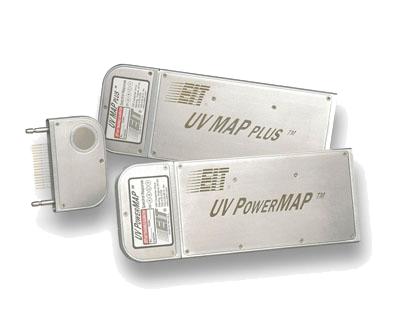- Home
- UV Curing
- UV Spot Curing
- UV radiometers
- EIT Powermap Plus
EIT Powermap Plus
The UV PowerMAP® and UV MAP Plus™ measure UV irradiance, radiant energy density and temperature. The UV PowerMAP® simultaneously provides information for four spectral regions (EIT® UVA, UVB, UVC, and UVV) while the UV MAP Plus™ provides for any one spectral region. Both instruments also provide a plot of the UV irradiance and temperature as a function of time.
Both instruments feature:
- User adjustable sampling rates from 128 to 2048 samples/second. The faster sample rates ensure high resolution and repeatability even at higher process speeds.
- Easy to use PowerView™ software program that displays collected data in graphical and tabular forms. The PowerView™ software allows the user to also compare two different files.
- Detachable Optics Head that allows the use of different optics heads with a single Data Collection Unit- (UDC). This feature minimizes downtime during re-calibration and allows a single UDC to use low and high power optics heads. Users that start with a single channel UV MAP Plus™ Optics Head have the ability to upgrade to the four channel UV PowerMAP® as their needs and measurement requirements change.
- Collection and storage of up to one million data points for accurate UV and temperature mapping in your system.
- Offset optics allow easy measurement at conveyor edge.
- Type J thermocouple records temperatures from 0-500oC.
- Low, narrow profile to allow access to most curing applications.
- Rugged aluminum chassis and stainless steel case.
The EIT® PowerMap Plus records the UV intensity and temperature throughout a UV curing system. It also simultaneously measures peak power density and total energy density in four spectral regions. It uses 4 UV detectors (UVA, UVB, UVC and UVV visible) and it provides the user with a graphic profile of each part of the UV spectrum. It is supplied with Windows based PowerView software. It has an adjustable sampling rate from 128 to 2048Hz, and it is used in high sampling rate to view lamp and power supply stability. As a result, it provides an excellent analysis of any UV curing system, and it provides solid SPC information.
